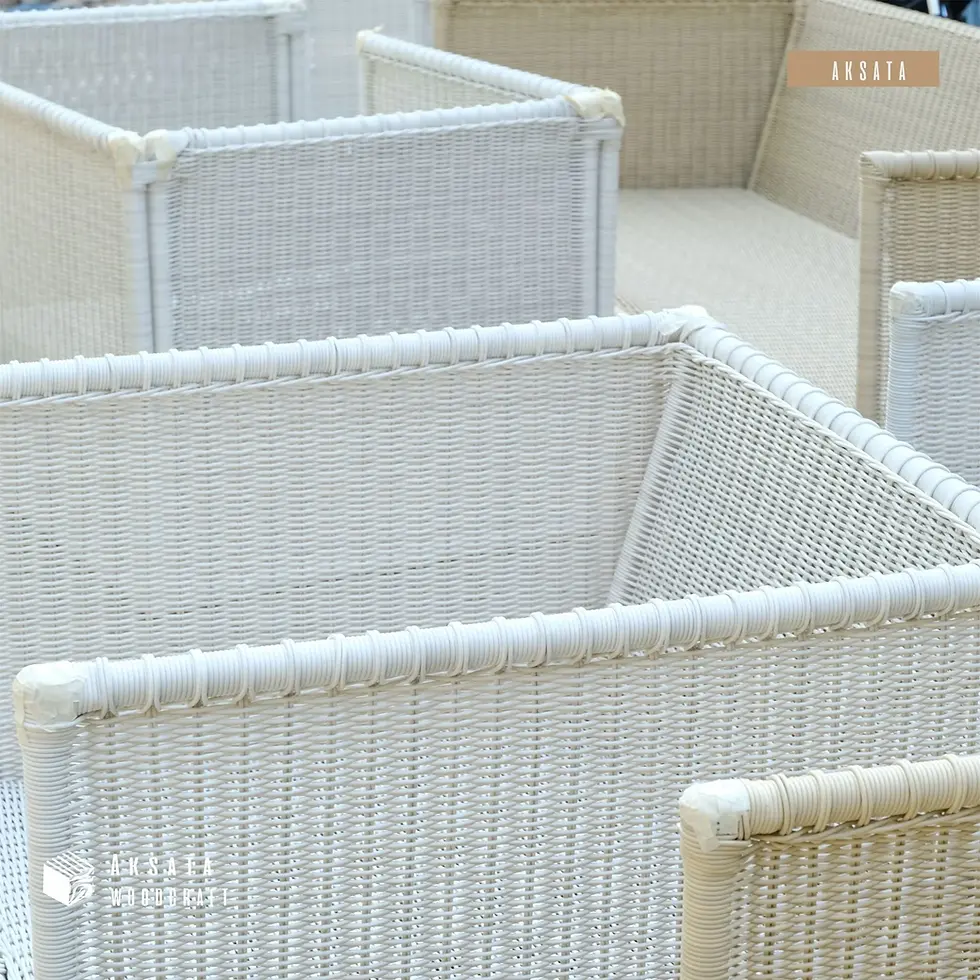Choosing Between Synthetic and Natural Rattan: Insights from the Manufacturer’s Perspective
- aksata woodcraft
- Feb 11
- 2 min read
Choosing Between Synthetic and Natural Rattan: Insights from the Manufacturer’s Perspective
When it comes to stylish, timeless furniture, rattan is a top choice — but should you go with natural rattan or synthetic rattan? As a seasoned rattan furniture manufacturer, we’re often asked this question by interior designers, retailers, and hospitality buyers.
Here’s a detailed, insider look at the pros, cons, and best-use cases of synthetic vs natural rattan, so you can make an informed decision for your next project.
1. What Is Natural Rattan?
Natural rattan is a vine-like plant that grows in the tropical forests of Southeast Asia — especially Indonesia. It’s a renewable, eco-friendly material that has been used for centuries in handmade furniture and home décor.
Key Characteristics:
Lightweight but sturdy
Biodegradable
Flexible and suitable for intricate weaving
Beautiful natural texture and color variations
✅ Best used for indoor furniture or in covered outdoor areas.
2. What Is Synthetic Rattan?
Also known as PE rattan or all-weather wicker, synthetic rattan is a man-made fiber, typically made from polyethylene. It is engineered to mimic the look of natural rattan, but with higher resistance to moisture, UV rays, and temperature changes.
Key Characteristics:
Highly durable
Waterproof and UV-resistant
Low maintenance
Available in consistent colors and textures
✅ Ideal for outdoor lounges, poolside furniture, and commercial spaces exposed to the elements.
3. Design Aesthetics and Feel
Natural Rattan: Offers an authentic, artisanal feel. Each piece has slight variations in color and grain — perfect for projects with a handcrafted or tropical theme.
Synthetic Rattan: Has a more uniform, polished appearance. It’s often preferred for minimalist or modern outdoor settings where consistency matters.
🎨 Natural = rustic charm. Synthetic = sleek precision.
4. Durability and Climate Considerations
Natural rattan does not perform well in direct sunlight or high humidity over long periods — it may fade, crack, or mold if not maintained properly.
Synthetic rattan is designed for harsh weather conditions and requires little upkeep. It can last 5–10 years outdoors with minimal fading.
🌦️ For outdoor-heavy projects, synthetic wins in durability.
5. Sustainability and Environmental Impact
Natural rattan is a renewable and biodegradable resource, making it the preferred choice for eco-conscious projects.
While synthetic rattan is non-biodegradable, high-quality PE rattan can be recyclable and made with non-toxic materials.
🌱 Natural rattan is the greener choice — if used in the right environment.
6. Cost and Maintenance
Natural rattan may be slightly more expensive per piece due to handcrafting, and it requires occasional maintenance (dusting, avoiding moisture).
Synthetic rattan is often more affordable in bulk and easier to clean (just wipe or hose down).
💸 Synthetic may lower long-term costs, especially for hospitality projects with high usage.
Manufacturer’s Recommendation
At CV Aksata Furnicraft International, we offer both natural and synthetic rattan furniture — and we often advise our clients based on their end-use environment, design vision, and brand values.
Conclusion
When choosing between synthetic and natural rattan, there’s no one-size-fits-all answer. Each material has unique benefits — and understanding these from the manufacturer’s perspective helps you select the right option for your project’s function, aesthetic, and longevity.








Comments